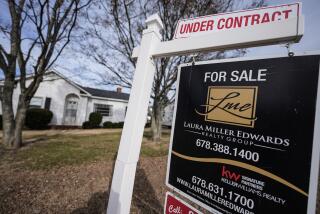Home Buyers May Get Break on Mortgages : Agencies Could Cut Rates Slightly in ’89
- Share via
WASHINGTON — The ceiling on the size of home mortgages purchased by secondary mortgage-market agencies likely will rise to $187,600 next year from $168,700 this year, the government said Tuesday. That could mean cheaper mortgages, by a quarter point or so, for many home buyers.
The changes must be approved by the boards of the Federal Home Loan Mortgage Corp., known as Freddie Mac, and the Federal National Mortgage Assn., or Fannie Mae.
Both agencies were established by the government to buy mortgages and repackage them into securities for sale to investors. The process is designed to make loans at competitive interest rates available to home buyers.
However, mortgages exceeding the limits are considered “non-conventional.” They cannot be sold through Fannie Mae and Freddie Mac, and financial institutions generally charge somewhat higher rates because they often must hold them in their own portfolio.
The Federal Home Loan Bank Board said the average price of homes financed by conventional mortgages was $136,900 in early October, an 11.2% increase from a year earlier. Under the formula used by both Freddie Mac and Fannie Mae, the maximum mortgage loan size will increase proportionately in January.
Average Fixed Rate 10.82%
The increased limits will be particularly important in the Northeast and on the West Coast, where average home prices are much higher than elsewhere.
Warren Lasko, executive vice president of the Mortgage Bankers Assn. of America, said potentially about 350,000 home buyers, 8% to 10% of the market, could benefit from the higher ceiling and save about a quarter of a percentage point on mortgage rates. On a mortgage of $175,000, that amounts to $440 a year.
“It doesn’t knock your socks off, but it helps,” he said.
Meanwhile, the bank board said the average rate on fixed-rate mortgages offered in early October, including add-on fees known as points, was 10.82%, down from 10.95% in early September. The average for the most popular type of adjustable-rate mortgages, those with caps on how high the rate can go, fell from 9.19% to 9.13%.
More recently, rates have been rising. Freddie Mac reported averages, not including points, of 10.31% last week, up from a recent low of 10.12% two weeks earlier.
“Unfortunately we don’t think they’ve topped out yet,” Lasko said. “We’re looking for interest rates to continue trending upward (by a half to three-quarters of a percentage point) through the first quarter of 1989 and then move downward.”
More to Read
Inside the business of entertainment
The Wide Shot brings you news, analysis and insights on everything from streaming wars to production — and what it all means for the future.
You may occasionally receive promotional content from the Los Angeles Times.










